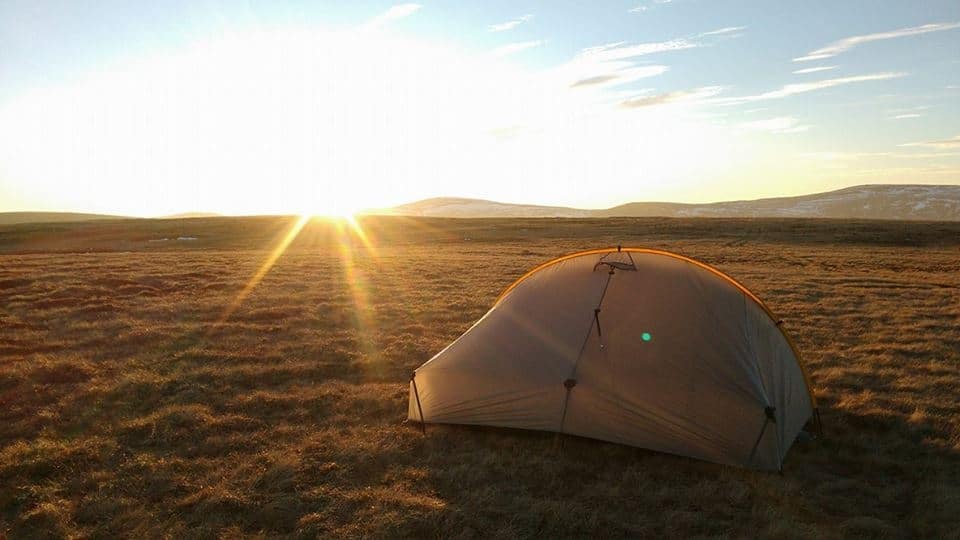One of the great joys of wild camping is that your imagination is the limit as to where you sleep for the night. Literally, you can walk along and decide ‘that spot looks great for the night’… but what makes a great wild camp spot? There are only three things we need from a camp spot:
1. Relatively flat
2. Relatively dry
3. Relatively sheltered
However digging a bit deeper into these it is clear that so much of whether a spot is good or not depends on the weather you expect, and your willingness for discomfort or compromise. For example on a windy day, shelter from the wind will be the most important factor. If it’s really wet, then somewhere that drains well will take the lead… and of course you need to remember that you might need water from somewhere nearby, or plan ahead of not.
Given all this it might seem daunting to set out not knowing where you might be able to put up your tent but it doesn’t have to be. For your first trip I would strongly recommend choosing somewhere you know, or have scouted beforehand.
Here’s what helps us find a suitable spot when we head out to new places:
Check the map beforehand
We particularly look for areas where the contour lines spread out indicating flatter ground. Likely locations include:
- Areas near a moderate sized river which are (hopefully) quite well drained
- Areas on lake/lochan/tarn shores where often some flat ground can be found
- Areas on saddles can often be good, but exposed to wind unless you can tuck behind an outcrop
- Summits can be good, but exposed!
- Edges of woodlands or clearings can provide excellent shelter and sometimes flat areas. Keep an eye out for potential weak trees.
Keep a mental inventory as you walk
We normally start keeping our eyes open for potential spots about two hours before we plan to stop, just in case we get tired or have no luck with our target area.
- Be aware of how you are feeling. If you are getting tired, stopping at an acceptable spot is better than pushing on to what you hope might be a fantastic spot
- Rank the spots you see given the conditions
- Don’t be afraid to stop early if you see a great spot
- Look around corners/behind outcrops – it is surprising what a difference 50m or so can make in terms of shelter/flatness/dryness
Compromise
Inevitably, it is rare to find a ‘perfect’ spot, but that is part of the fun. Be prepared that you might just have to compromise on your spot. For example:
- In windy conditions, shelter is more important than view
- In wet conditions, dryer ground is more important than flat ground
- If you are tired, somewhere to stop before you have an accident is better than continuing
Remember it’s an adventure
Often we don’t manage to find flat short grass near a babbling stream. This is part of the adventure, so remember some wild camps might be less than ideal. In the past we have chosen spots where we have had to walk to get water, had to try to flatten out tussock grass, ended up pitched on stones, had the ground quite boggy, prayed that the wind doesn’t get any stronger because we were far too exposed… All these less than ideal spots have worked out to be great so long as you are willing to accept it as an adventure, and as with everything in life, take the rough with the smooth!
Final thoughts
Getting out there and trying wild camping is great fun and makes for great family adventures. It doesn’t need to be daunting at all. Remember if you are just starting out then going to somewhere you know, even the back garden or scouting a spot first is a good idea, as is using the internet to look for tips. You may find that people are normally vague about exact spots though. After all, part of the fun of wild camping is finding your own spot, which maybe no one else has camped on before…
Please do consider supporting the Love Her Wild community by becoming a Patreon! Not only will you be helping women in accessing the outdoors, but there are great benefits including giveaways and access to an exclusive newsletter.
Stacey loves spending time outdoors with her husband and 5yo son wildcamping and munrobagging as often as they can. She’s also frantically working on converting a van so that come the summer, she and her family can hit the road for 4 weeks with a fundraising adventure in mind.

